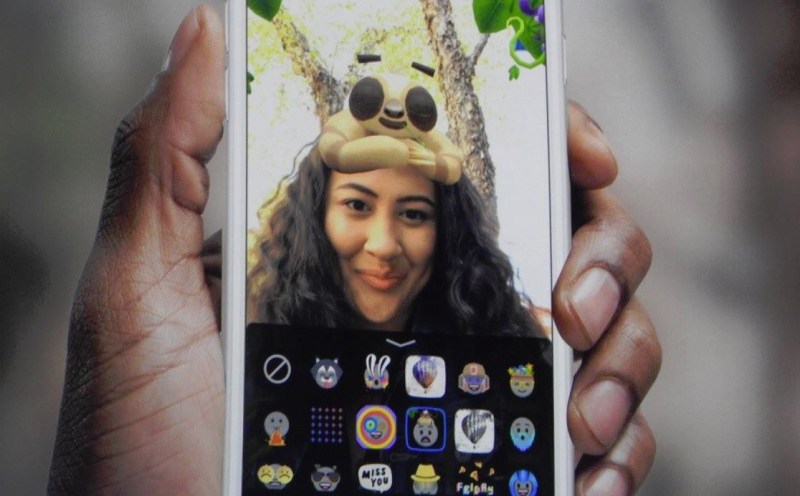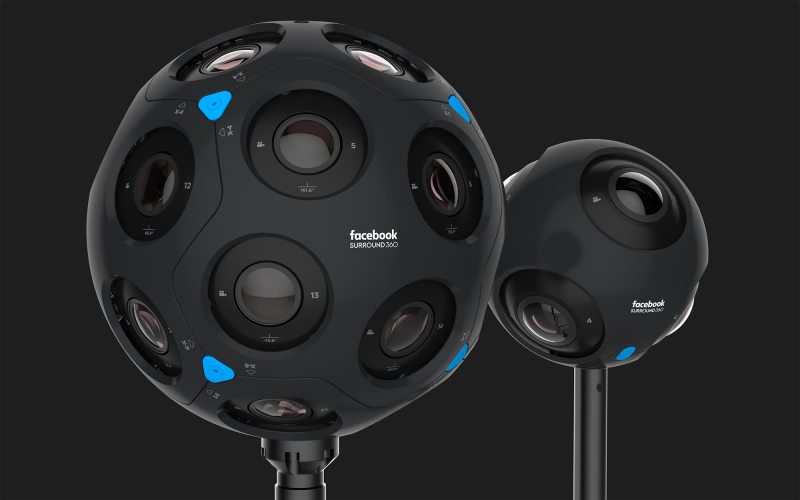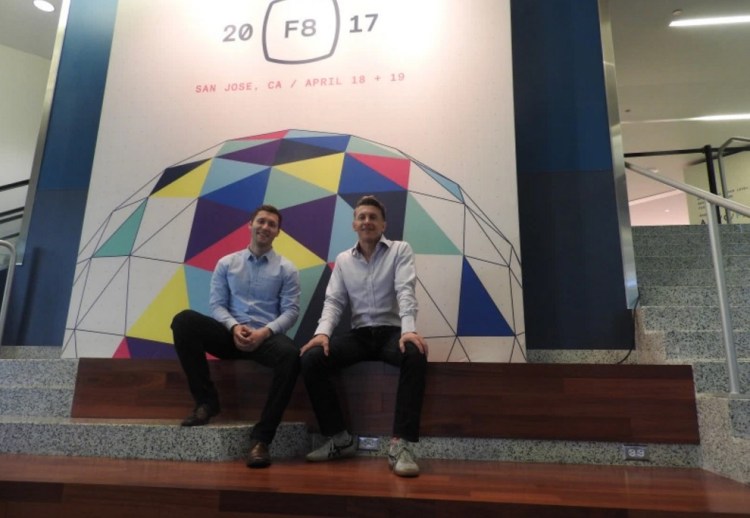
Above: Facebook’s augmented reality platform at F8.
GB: Is it possible to hand your stream over to someone else when you need a break from it?
Ellis: We’ve just started working with entertainers, and we’re getting all sorts of feedback. Every week we’re learning new things. That’s going to help us build. If that’s something they feel strongly about, we’ll listen to that.
Cross: We’re also trying to provide more monetization forms. If you have to take a break, what better way to use that than to make some money from it? We’ve been testing the ability for our partners to insert mid-reel ad breaks in their video, including live streams of their games. That gives them a way to step away, monetize, and come back. Hopefully with our targeting the ads are much more relevant.
The last part is something we feel especially excited by, because it’s an area where we’re clearly the leader. That’s the friends tier. Most platforms don’t think about this layer, but we think it’s incredibly important. People love to share the games they play. They want validation and feedback. They need sharing to be easy. They need control of privacy and the ability to manage their audience flexibly. They need their sharing and their consumption experiences to be consistent and available across all the platforms they play on, and that their friends enjoy content on.
June 5th: The AI Audit in NYC
Join us next week in NYC to engage with top executive leaders, delving into strategies for auditing AI models to ensure fairness, optimal performance, and ethical compliance across diverse organizations. Secure your attendance for this exclusive invite-only event.
We’ve been doing this for 10 years, as you know. Video presents its own unique challenges. We’ve made a lot of updates to our products to handle video, especially live video. We’re well on the way there, but with lots of work still to do. This is an area where we’ve already got our sharing tools on PC, console, web.
Ellis: We started with our Blizzard partnership last year, which was really exciting. It was a ground-breaking new social integration, where people could stream directly from the game client to people on Facebook. They had an audience already, which was really cool.
We’ve built on that. We announced at CES that we’re working with Nvidia to empower people in more than 400 games, so they can go live at the push of a button. It’s part of GeForce Experience, the software layer.

Above: Crowds at City National Civic in San Jose, Calif. persist after the performance of Chance the Rapper at the end of day one of the Facebook developer conference F8 on April 18, 2017.
Cross: One important point about the friends layer, it’s not just the people you’re friends with on Facebook. It’s the people you’re connected to through Facebook groups related to games. A huge number of gaming groups on Facebook and the activity within them is related to games. We’re working on making it easy to share to specific groups when you’re live streaming or uploading your VOD highlights or whatever. When we say “friends,” we mean more than just friends. We mean everyone you’re connected to through groups.
There are about a billion people in groups right now, and a lot of that activity is around games. We haven’t yet served them as a community. You’ve followed Facebook and gaming for a while, I’m sure. I’ve been there a while. One thing I’m excited by, we’re finally thinking about the people who use Facebook to play with each other as a community we’re trying to support. Being able to share their groups and manage a group is critical there.
I mentioned updating our share tools to handle video, and live video in particular. One thing we need to do is create a way for people to share through our API. If you’re broadcasting from XSplit, say, we need to let you specify which groups you want to share to and manage the privacy and make it flexible. One day you may stream to yourself as you practice. Another time you might go public because you’re trying to start a business. Another time you might stream all day long to a hardcore set of your Facebook connections. We want to provide something flexible over time so you can change all that.
That’s what we’re announcing here: the ability to do just that. We feel that’s just the start of what we mean by taking these assets we have – pages, groups, Messenger, events, the social graph – and starting to update them so they can handle video and gaming communities much more thoughtfully.
Ellis: It’s early days. It’s not even just early days for us. We think it’s early days for gaming video overall. Every day we come in we’re excited, because we’re shaping the future of gaming video. We’re working with partners in esports. We have a long-standing relationship with developers. We’re working with guys like StoneMountain. As they work and collaborate with us, we’ll build the future of gaming video with them.
Cross: In the full presentation we explain how we’re building products. We give illustration of all the products that exist today – ad breaks, the control dialogs, all the desktop broadcasting tools.
GB: That’s a good match for what Twitch has been doing. Are you getting into the same feature set they have?
Ellis: The feedback from entertainers is that interactivity is incredibly important. We wanted to make that a lot easier for them.
GB: If there’s a feature set to match on competitive fronts, what about something like gifting from fans to entertainers? Is that happening?
Cross: We can’t comment on what’s in the works too much, but let’s just say that the interactivity we have today is just the start. We have reactions and commenting. We have ad breaks, which is a form of interaction. You’re interacting in some way with the entertainer by sticking through the commercial breaks and helping them generate revenue. But we’re definitely paying close attention to what’s happening. We’re also thinking about what we can do that’s different.
I’m excited by the innovation. I feel like Facebook coming into the market has lit a fire. It’s bringing attention to the fact that there’s a lot still to do here. We’re thinking very creatively and broadly about all the different forms of interactivity. What’s cool here—as you know, the gaming industry is the vanguard when it comes to taking advantage of new tech. Facebook obviously has big plans for video. We feel like we can help inform what we should be doing more broadly with video by leading with games.
We’re more aggressive about that than other teams inside Facebook. But the good news is we’re getting pretty good traction. The company is starting to realize that gaming is already doing these kinds of advanced interactions and people are building a business around it.

Above: Facebook Surround 360 (2017) x24 (left) and x6 (right).
GB: Beam and Microsoft were talking about their very low-latency solution, so chat could keep up with the stream.
Cross: We have a partnership with Microsoft that ties to the whole Xbox and Windows 10 platforms. We have what you can call our SDK integrated into PC, mobile, and their console. We’ve been talking with them for some time and we’re impressed with what Beam has started doing and what they’re planning to do.
Where Facebook might be able to help is with things like scale – making this more available and more scalable. We’re used to dealing with a global audience, very large audiences. Hats off to them, because they’re doing some amazing stuff. I’m excited by how we can partner with those guys.
Ellis: If you’re an entertainer in someplace like the U.K., you want to make sure you’re interacting with your audience in real time. That’s one of the unique things about live game streaming that sets it apart from other forms of entertainment. I remember riffing with my fans all the time. They’d comment and go crazy about something, and I’d engage with that idea and say something, and the chat would go wild. That real time interactivity differentiates us from other forms of entertainment.
Cross: There are plenty of ways to improve the standard tech, whether it’s latency or video quality. The part we’re excited about—it needs to be good, but it doesn’t have to be amazing. It’s no value to me if I have low latency, but there’s no one engaging with my content. If my content is lost in a sea of other content, or there’s no community there, it doesn’t matter. I’ll deal with a couple of seconds of latency if I get great feedback, if I can feel like this is my community, if I get that validation I’m looking for.
We all have to figure this out. It’s still relatively new. There are some awesome examples of feature sets that are valuable and that are working, but it’s just the start. We have a lot of opportunities to make it better.

Above: Esports is big, but it could grow a whole lot larger.
GB: Gifting seems to be something the Chinese are doing a lot with now.
Ellis: When I was an entertainer, in the past—trying to differentiate yourself from other entertainers is important. You want to stand out from the crowd. That all starts with interactivity, how you express and brand yourself as an entertainer. We know there’s a lot more we can do there to help people express themselves in different ways. We’re beginning to work on that. Desktop broadcasting is one of the early indications of the work we’re doing there, helping improve the interactivity between both the entertainer and the viewer. That’s the critical part of what can make us unique.
Cross: That’s one of the things that makes StoneMountain stick for me. He plays a lot of Battlefield One. He’ll do this shtick where he’s the commanding officer in a platoon, and he talks to his other platoon mates like he’s a drill sergeant.
Ellis: I captained professional teams before, but I think playing a game with him would be way more intense. “Guy on your six! Guy on your six!”
Cross: “Drop and give me 30!” [laughs] I’ve played a bit of Battlefield. I’m not a huge fan. But I’ll watch him.
Ellis: He calls it “squad up.” It’s part of his brand. He squads up. Allowing them to express themselves differently—there are thousands of entertainers out there. How do you stand out from the crowd?
Cross: The way we work on platforms is we try and build dialogs. The self-contained Facebook elements, you can call those into a game to do what you want to do, like sharing a video with desktop broadcasting. But we’ll also typically provide an API for the more advanced developers and the more creative ones, people who are ahead of us in how they’re thinking about interactivity and making things more creative in the content production or consumption experience.
As I mentioned, we’re just now launching this group API. We have this shared dialog with desktop broadcasting. We’re going to expand on those. Interactivity is one of the key things we’re trying to solve for. We’ll do that with a dialog for the masses approach, and then an API for the real creative leaders in the space.
Last week we announced with the 76ers that they’re coming in to stream. They have Team Dignitas, the first major North American sports franchise to acquire an esports team. They’ll be streaming on the platform. We’re looking at each tier as little mini-beats, around the creation side and around the viewing experience. We’ll have quite a few this year coming up.


